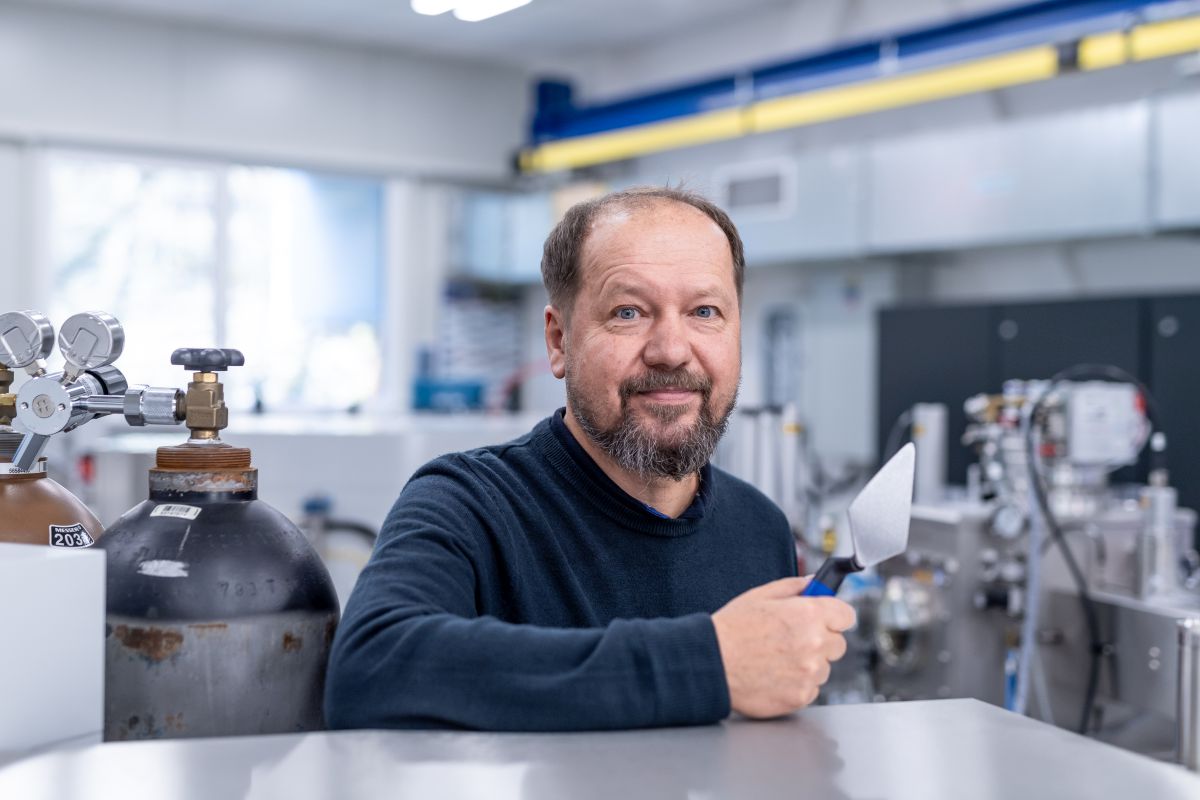
The first humans came to Europe 1.4 million years ago
06. 03. 2024
The oldest currently known human occupation of Europe lies near the town of Korolevo in western Ukraine. New findings by an international team led by Roman Garba from the Nuclear Physics Institute of the Czech Academy of Sciences (CAS) and Institute of Archaeology of the CAS, Prague, have confirmed that the lowermost layer with the stone tools at Korolevo dates to 1.4 million years ago. Until now, the earliest inhabited location was thought to be Atapuerca in Spain, some 200,000 to 300,000 years later. The results, published today in Nature, also show that early hominins took advantage of warm interglacial periods to colonise Europe from the east or southeast. A recent advance in mathematical modelling combined with applied nuclear physics has enabled the precise dating of the Korolevo’s earliest occupation. The four-year long research project involved scientists from five countries and more than ten research institutions from around the world.
The new study changes the view of the dispersal routes of the “first Europeans” and fills in the missing piece of the mosaic of what we know about the history of the first peopling of Europe. The Korolevo site, in present-day Zakarpattia Oblast (Transcarpathia), near Ukraine’s borders with Romania and Hungary, is also believed to be the northernmost known occurrence of Homo erectus in the world. The Korolevo site contains only stone tools, but due to their determined age, it is assumed that H. erectus occupied Europe by this time.
“Our earliest ancestor, H. erectus, was the first of the hominins to leave Africa about two million years ago and head for the Middle East, East Asia, and Europe. The radiometric dating of the first human presence at the Korolevo site not only fills in a large spatial gap between the Dmanisi site in Georgia and Atapuerca in Spain, but also confirms the hypothesis that the first pulse of hominin dispersal into Europe came from the east or southeast,” the lead author of the study, Roman Garba from the Nuclear Physics Institute of the Czech Academy of Sciences (CAS) and the Institute of Archaeology of the CAS in Prague, sums up the research findings. “Based on a climate model and field pollen data, we have identified three possible interglacial warm periods when the first hominins could have reached Korolevo following most likely the Danube River migration corridor,” Garba adds.
The prehistoric archive of Europe
The archaeological site of Korolevo is important for Europe as a whole. “We know that the layer of accumulated loess and palaeosol here is up to 14 metres deep and contains thousands of stone artefacts. Korolevo was an important source of raw material for their production,” explains Vitalii Usyk, a Ukrainian archaeologist and co-author of the study who took part in the excavations at Korolevo and now works at the Institute of Archaeology of the CAS in Brno.
“We identified seven periods of human occupation in the stratigraphic layers although at least nine different Palaeolithic cultures were recorded in the locality: hominins lived here from 1.4 million years ago to about 30,000 years ago,” the researcher adds.
The discovery shows the importance of integrating know-how from distant scientific disciplines to learn about the past. Without the knowledge and technological capabilities of nuclear physics and geophysics, archaeologists would not have been able to conclusively confirm that the stone tools dated to this early period.
Cosmic clock for human history
The cobble-sized clast samples from the lowermost cultural layer of the Korolevo site were chemically processed by researchers from the Czech Republic and Germany and measured at the Helmholtz-Zentrum Dresden-Rossendorf by accelerator mass spectrometry (AMS) using the DREAMS (DREsden AMS) facility. In 2022, the Nuclear Physics Institute of the CAS opened an AMS laboratory in Řež, making it now possible to carry out similar measurements in the Czech Republic.
Burial-dating methods using cosmogenic nuclides can date rocks as old as five million years.
“At the Korolevo site, we specifically measured the concentrations of cosmogenic nuclides beryllium-10 and aluminium-26 which have different half-lives, 1.39 million years and 708 thousand years respectively."
"These nuclides accumulate in the quartz grains when the rock is at the surface due to cosmogenic radiation from the space, but they begin to decay when they become buried in the ground. The ratio of the two varies according to how long the clasts were buried beneath the ground surface,” explains Roman Garba, an archaeologist who uses applied nuclear physics methods in his research. “This allows us to calculate their age since burial.”
New dating approach implemented for the very first time in archaeology
Determining the age of sediments containing the stone tools fell to the geochronological expertise of John Jansen from the Institute of Geophysics of the CAS, and Mads Knudsen from Aarhus University, Denmark.
“We applied two complementary dating approaches to calculate the age from the measured concentrations of cosmogenic beryllium-10 and aluminium-26. But the most precise age came from our own method based on mathematical modelling, known as P-PINI. This study is the first time our new dating approach has been applied in archaeology,” John Jansen says.
“I expect our new dating approach will have a major impact on archaeology because it can be applied to sedimentary deposits that are highly fragmented, meaning there are lots of erosional gaps. In archaeology we nearly always find fragmented records, whereas the traditional long-range dating method, magnetostratigraphy, relies on more continuous records.”
The research was carried out on the basis of an agreement signed between the Nuclear Physics Institute of the CAS and the Institute of Archaeology of the National Academy of Sciences of Ukraine. The project was supported by the European Commission (Horizon 2020, RADIATE, No. 824096), the Ministry of Education, Youth and Sports of the Czech Republic (CZ.02.1.01/0.0/0.0/16_019/0000728 and LM2018120), the Czech Science Foundation (22-13190S), and the Charles University Grant Agency (310222).
In addition to the Nuclear Physics Institute of the CAS, the Institute of Geophysics of the CAS, and the Institutes of Archaeology of the CAS in Brno and Prague, the Czech research institutions involved were the Department of Physical Geography and Geoecology of the Faculty of Science, Charles University and the Czech Geological Survey. Regarding the international involvement of institutions, it is necessary to mention the Institute of Archaeology of the National Academy of Sciences of Ukraine (Kyiv, Ukraine), Helmholtz-Zentrum Dresden-Rossendorf (Germany), Aarhus University (Denmark), Department of Archaeology and History, La Trobe University (Melbourne, Australia), and Taras Shevchenko National University of Kyiv (Kyiv, Ukraine).
Publication:
Further details can be found in the study published in Nature.
R. Garba, V. Usyk, L. Ylä-Mella, J. Kameník, K. Stübner, J. Lachner, G. Rugel , F. Veselovský, N. Gerasimenko , A. I. R. Herries, J. Kučera, M. F. Knudsen & J. D. Jansen. East-to-west human dispersal into Europe 1.4-million-years-ago. Nature 627 (2024). DOI: 10.1038/s41586-024-07151-3
Contact information (Czech institutions):
Ing. Mgr. Roman Garba, Ph.D.
Nuclear Physics Institute of the CAS and Institute of Archaeology of the CAS, Prague
garba@ujf.cas.cz
Vitalii Usyk, Ph.D.
Institute of Archaeology of the CAS, Brno
vitaly.i.usik@gmail.com
Ing. Jan Kameník, Ph.D.
Nuclear Physics Institute of the CAS
kamenik@ujf.cas.cz
John Jansen, Ph.D.
Institute of Geophysics of the CAS
jdj@ig.cas.cz
RNDr. František Veselovský
Czech Geological Survey
frantisek.veselovsky@geology.cz
Prof. Ing. Jan Kučera, CSc.
Nuclear Physics Institute of the CAS
kucera@ujf.cas.cz

Roman Garba is an archaeologist and works in the applied physics field, too.
Photo: Jana Plavec, Czech Academy of Sciences
Download the press release here.
Read also
- How lakes connect to groundwater critical for resilience to climate change
- A unique method of rare-earth recycling can strengthen the material independence
- High-energy cosmic rays dominated by heavy METALS
- Genome Tool Developed at CAS Featured in PLoS Genetics
- Why do brain cancer cells steal mitochondria?
- Secrets of the Nano- World: a new comic book about nanotechnology
- Teen duo from Slovakia and Czechia named Global Winner for clean water solution
- Professor Pavel Hozák Receives the Paul Nakane Prize
- Neutrino is lighter than previously thought
- The Earth Prize 2025 goes to Czechia and Slovakia for pioneering water purifier
Contacts for Media
Markéta Růžičková
Public Relations Manager
+420 777 970 812
Eliška Zvolánková
+420 739 535 007
Martina Spěváčková
+420 733 697 112